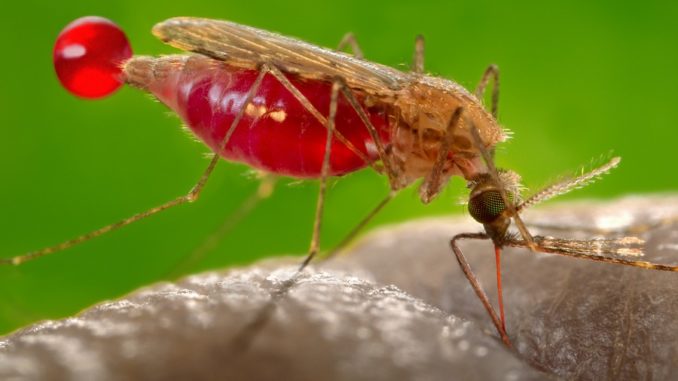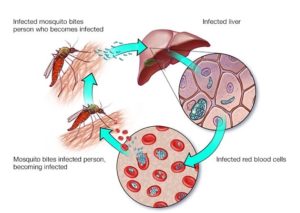
Table of Contents
What is Malaria?
- Malaria is a mosquito-borne febrile illness caused by a parasite called Plasmodium, which spread to the people through the bite of infected female Anopheles mosquito.
- Malaria is a life-threatening disease.
- Malaria gets its name from an Italian word ‘Mal Aria’ meaning ‘bad air’
- Malaria is an infection of liver and RBCs by the protozoan parasites which is serious and sometimes life threatening
- People with malaria often experience high fever, shaking chills and flu-like illness and the symptoms appears 10-15 days after infective bite
- The disease is uncommon in temperate climates but is seen in tropical and subtropical countries
- Malaria is mainly caused by 5 (five) species of Plasmodium commonly infecting a certain type of mosquito which feed on humans. Plasmodium species includes:
- Plasmodium falciparum (cause most life-threatening malaria)
- Plasmodium vivax
- Plasmodium ovale
- Plasmodium malariae
- Plasmodium knowlesi
Key Facts About Malaria
- Malaria is widely distributed in tropics and sub-topics of Africa, Asia and Latin America
- An estimated 241 million malaria cases were seen worldwide in year 2020 and estimated number of malaria deaths were 627,000
- High shares of global malaria burden is disproportionately shared by WHO African region
- Malaria is caused by a parasite caused Plasmodium.
- Malaria is a great drain in the national economy of many countries as it causes many illness and deaths
- Malaria is most common in the tropical and sub-tropical areas of the world, including:
- Africa
- Central and South America
- Papua New Guinea
- Asia
- West pacific islands
- Malaria already exists among the poorer nations, the disease maintains a vicious cycle of disease and poverty
- Malaria is a preventable and curable disease
Common Misconceptions About Malaria
- Malaria is present everywhere in the south east Asia
- Once you get malaria, you are immune to it
- Malaria can be prevented from vaccine
- Use of anti-malarial drug can surely cure malaria
- Malaria is a tribal illness
- Once you get malaria, it will stay life-long in the body
Transmission of Malaria
- Malaria is transmitted to human body by the bite of female Anopheles mosquito carrying plasmodium species
- As malaria parasite can be found in the red blood cells of infected person. Thus it can be transmitted through blood transfusion, organ transplant, or the shared use of needles or syringes contaminated with blood
- It can also be transmitted from a mother to her unborn infant before or during delivery (“congenital” malaria)

Who is at Risk of Malaria?
- Anyone can get malaria. Most cases occur in the people who are living or travelling in a region where malaria is present
- People travelling to area where malaria is common:
- Without taking medicine to prevent malaria
- Being outdoors
- Not protecting self from mosquito bites
- Pregnant women and children under 5 years are at more risk
- Patients with HIV/AIDs
Incubation Period
Generally, the incubation period of Malaria ranges from 7-30 days. Incubation period varies according to the parasite. Incubation period of malaria for different parasites are:
- Plasmodium falciparum: 9 to 14 days
- Plasmodium vivax: 12 to18 days (but some strains may have an incubation period of 8 to 10 months or longer)
- Plasmodium ovale: 12 to 18 days
- Plasmodium malariae: 18 to 40 days
- Plasmodium knowlesi 9 to 12 days.
Signs and Symptoms of Malaria
Symptoms of Malaria usually appear within 10-15 days after the infected mosquito bites a person.
- High fever with headache
- Chills with rigors
- Restlessness, Anorexia,
- Headache
- Nausea
- Diarrhea
- Profuse sweating
- Abdominal pain
- Cough
- Arthralgia (joint pain)
- Vomiting, anemia
- Muscle and joint pain
- Hepatosplenomegaly
- Convulsions
- Coma (if severe)
Diagnosis of Malaria
- Thick and thin smears
- Rapid diagnostic test
- PCR
- Molecular test
- Antibody test
Malarial Fever
Malaria can be classified as uncomplicated malaria and severe malaria.
1. Uncomplicated Malaria
Usually, malaria attacks for 6-10 hours. During this period, malaria fever undergoes three stages:
- Cold stage (sensation of cold and shivering)
- Hot stage (fever, headaches, vomiting; seizures in young children)
- Sweating stage (sweats, return to normal temperature, tiredness)
2. Severe Malaria
It occurs when infections are complicated by serious organ failures or abnormalities in a patient. It should be treated urgently without any delay. Manifestations of severe malaria include:
- Cerebral malaria, with abnormal behavior, impairment of consciousness, seizures, coma, or other neurologic abnormalities
- Severe anemia due to hemolysis (destruction of the red blood cells)
- Hemoglobinuria (hemoglobin in the urine) due to hemolysis
- Acute respiratory distress syndrome (ARDS), an inflammatory reaction in the lungs that inhibits oxygen exchange, which may occur even after the parasite counts have decreased in response to treatment
- Abnormalities in blood coagulation
- Low blood pressure caused by cardiovascular collapse
- Acute kidney injury
- Hyperparasitemia, where more than 5% of the red blood cells are infected by malaria parasites
- Metabolic acidosis (excessive acidity in the blood and tissue fluids), often in association with hypoglycemia
Preventive Measures of Malaria
- Effective vector control measures of using insecticide treated nets
- Use of indoor residual spraying
- Safe and cost- effective use of preventive chemotherapy especially for infants and pregnant mothers
- Vaccination for the children as recommended by WHO
- Early diagnosis and treatment of malaria through diagnostic testing of all suspected cases and effective anti-malarial drug use
- Regular monitoring of drug efficacy to ensure no anti-microbial resistance. If so a prompt alternative are to design soon
- Promoting the elimination of malaria through effective integrated vector control measures
- Improved surveillance of malaria case and deaths to design effective interventions and evaluate the impact of malaria control programs
- Improved personal behavior like use of mosquito repellent, covering of skin while working outdoors, sleeping under nets
- Environment cleanliness as mosquito breeds in dirty environment
Treatment of Malaria
- For the treatment of malaria, geographical susceptibility of P. falciparum to antimalarial drugs and the type of plasmodium species are taken in consideration
- Antimalarial drugs include:
- chloroquine
- hydroxychloroquine
- primaquine
- artemisinin-based therapy
- atovaquone-proguanil
- The treatment period usually last 2 days but may vary according to severity
WHO Response on Malaria
- As a response to malaria elimination WHO has developed global technical strategy which includes:
- setting, communicating and promoting the adoption of evidence-based norms, standards, policies, technical strategies and guidelines;
- keeping independent score of global progress;
- developing approaches for capacity building, systems strengthening, and surveillance; and
- Identifying threats to malaria control and elimination as well as new areas for action.
- The strategy is built on major 3 pillars which are:
- Pillar 1. Ensure access to malaria prevention, diagnosis and treatment as part of universal health coverage
- Pillar 2. Accelerate efforts towards elimination and attainment of malaria-free status
- Pillar 3. Transform malaria surveillance into a key intervention
- Supporting elements of these pillars include:
- Harnessing innovation and expanding research
- Strengthening the enabling environment for more sustainable and equitable results
References and For More Information
https://www.cdc.gov/parasites/malaria/index.html
https://www.who.int/news-room/fact-sheets/detail/malaria
https://www.mayoclinic.org/diseases-conditions/malaria/symptoms-causes/syc-20351184
https://www.webmd.com/a-to-z-guides/malaria-symptoms
https://jamanetwork.com/journals/jama/fullarticle/207172
https://www.who.int/health-topics/malaria#tab=tab_1